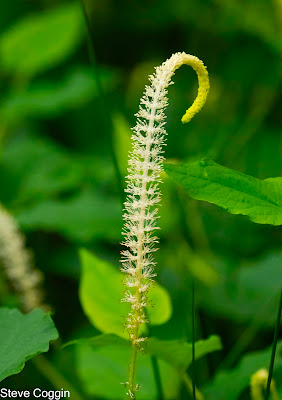 |
| Cardinal Flower (Lobelia cardinalis). Rowan County, North Carolina. |
Two beautiful flowers bloom in our southern swamps during the long hot summer. Lizard’s Tail (Saururus cernuus) and Cardinal Flower (Lobelia cardinalis) bring splashes of light to this dim environment and are important food sources for swamp creatures.
 |
| A stand of Lizard's Tail (Saururus cernuus). Rowan County, North Carolina. |
 |
| Flowers of Lizard's Tail. Rowan County, North Carolina. |
 |
| Lizard's Tail in fruit. Rowan County, North Carolina. |
 |
| A detailed view of the Cardinal Flower flowers. The reproductive structures arch above the rest of the flower. Rowan County, North Carolina. |
Cardinal Flower blooms late in the summer flashing red in the swamp. The brilliant scarlet flowers have five petals that are asymmetrically arranged with two petals on top and three below. The reproductive structures, both the male stamens and the female carpels, are fused. Together they arch over the flower with nectaries located at its base. Ruby-throated Hummingbirds are frequent visitors to Cardinal Flowers and as they sip nectar, pollen is deposited on their heads and beaks to carry to another flower. Cardinal Flowers are found in eastern North American, Mexico and into Central America. The common name comes from the flower's red color that reminded early American naturalists of the red robes of Roman Catholic Cardinals.
 |
| Cardinal Flower. Rowan County, North Carolina. |
Summer is a challenging time to visit southeastern swamps. They are hot, humid and buggy. But these
spectacular swamp things, Cardinal Flowers and Lizard’s Tail, make the challenge
worthwhile.






